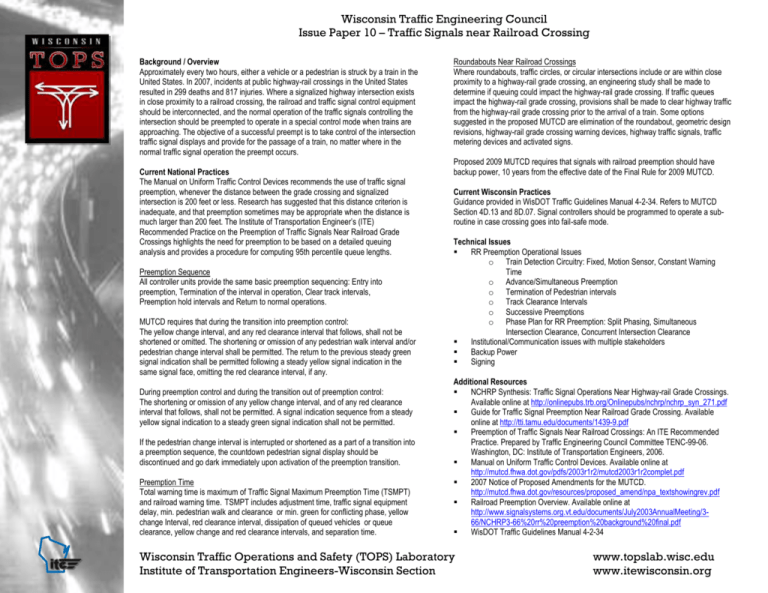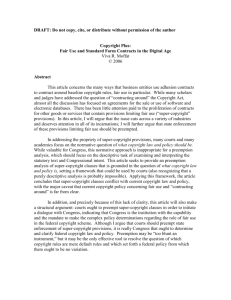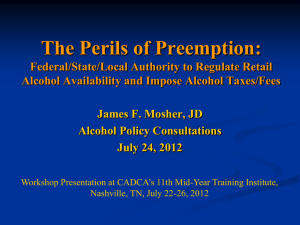Traffic Signals near Railroad Crossing
advertisement

Wisconsin Traffic Engineering Council Issue Paper 10 – Traffic Signals near Railroad Crossing Background / Overview Approximately every two hours, either a vehicle or a pedestrian is struck by a train in the United States. In 2007, incidents at public highway-rail crossings in the United States resulted in 299 deaths and 817 injuries. Where a signalized highway intersection exists in close proximity to a railroad crossing, the railroad and traffic signal control equipment should be interconnected, and the normal operation of the traffic signals controlling the intersection should be preempted to operate in a special control mode when trains are approaching. The objective of a successful preempt is to take control of the intersection traffic signal displays and provide for the passage of a train, no matter where in the normal traffic signal operation the preempt occurs. Current National Practices The Manual on Uniform Traffic Control Devices recommends the use of traffic signal preemption, whenever the distance between the grade crossing and signalized intersection is 200 feet or less. Research has suggested that this distance criterion is inadequate, and that preemption sometimes may be appropriate when the distance is much larger than 200 feet. The Institute of Transportation Engineer’s (ITE) Recommended Practice on the Preemption of Traffic Signals Near Railroad Grade Crossings highlights the need for preemption to be based on a detailed queuing analysis and provides a procedure for computing 95th percentile queue lengths. Preemption Sequence All controller units provide the same basic preemption sequencing: Entry into preemption, Termination of the interval in operation, Clear track intervals, Preemption hold intervals and Return to normal operations. MUTCD requires that during the transition into preemption control: The yellow change interval, and any red clearance interval that follows, shall not be shortened or omitted. The shortening or omission of any pedestrian walk interval and/or pedestrian change interval shall be permitted. The return to the previous steady green signal indication shall be permitted following a steady yellow signal indication in the same signal face, omitting the red clearance interval, if any. During preemption control and during the transition out of preemption control: The shortening or omission of any yellow change interval, and of any red clearance interval that follows, shall not be permitted. A signal indication sequence from a steady yellow signal indication to a steady green signal indication shall not be permitted. If the pedestrian change interval is interrupted or shortened as a part of a transition into a preemption sequence, the countdown pedestrian signal display should be discontinued and go dark immediately upon activation of the preemption transition. Preemption Time Total warning time is maximum of Traffic Signal Maximum Preemption Time (TSMPT) and railroad warning time. TSMPT includes adjustment time, traffic signal equipment delay, min. pedestrian walk and clearance or min. green for conflicting phase, yellow change Interval, red clearance interval, dissipation of queued vehicles or queue clearance, yellow change and red clearance intervals, and separation time. Roundabouts Near Railroad Crossings Where roundabouts, traffic circles, or circular intersections include or are within close proximity to a highway-rail grade crossing, an engineering study shall be made to determine if queuing could impact the highway-rail grade crossing. If traffic queues impact the highway-rail grade crossing, provisions shall be made to clear highway traffic from the highway-rail grade crossing prior to the arrival of a train. Some options suggested in the proposed MUTCD are elimination of the roundabout, geometric design revisions, highway-rail grade crossing warning devices, highway traffic signals, traffic metering devices and activated signs. Proposed 2009 MUTCD requires that signals with railroad preemption should have backup power, 10 years from the effective date of the Final Rule for 2009 MUTCD. Current Wisconsin Practices Guidance provided in WisDOT Traffic Guidelines Manual 4-2-34. Refers to MUTCD Section 4D.13 and 8D.07. Signal controllers should be programmed to operate a subroutine in case crossing goes into fail-safe mode. Technical Issues RR Preemption Operational Issues o Train Detection Circuitry: Fixed, Motion Sensor, Constant Warning Time o Advance/Simultaneous Preemption o Termination of Pedestrian intervals o Track Clearance Intervals o Successive Preemptions o Phase Plan for RR Preemption: Split Phasing, Simultaneous Intersection Clearance, Concurrent Intersection Clearance Institutional/Communication issues with multiple stakeholders Backup Power Signing Additional Resources NCHRP Synthesis: Traffic Signal Operations Near Highway-rail Grade Crossings. Available online at http://onlinepubs.trb.org/Onlinepubs/nchrp/nchrp_syn_271.pdf Guide for Traffic Signal Preemption Near Railroad Grade Crossing. Available online at http://tti.tamu.edu/documents/1439-9.pdf Preemption of Traffic Signals Near Railroad Crossings: An ITE Recommended Practice. Prepared by Traffic Engineering Council Committee TENC-99-06. Washington, DC: Institute of Transportation Engineers, 2006. Manual on Uniform Traffic Control Devices. Available online at http://mutcd.fhwa.dot.gov/pdfs/2003r1r2/mutcd2003r1r2complet.pdf 2007 Notice of Proposed Amendments for the MUTCD. http://mutcd.fhwa.dot.gov/resources/proposed_amend/npa_textshowingrev.pdf Railroad Preemption Overview. Available online at http://www.signalsystems.org.vt.edu/documents/July2003AnnualMeeting/366/NCHRP3-66%20rr%20preemption%20background%20final.pdf WisDOT Traffic Guidelines Manual 4-2-34 Wisconsin Traffic Operations and Safety (TOPS) Laboratory Institute of Transportation Engineers-Wisconsin Section www.topslab.wisc.edu www.itewisconsin.org











